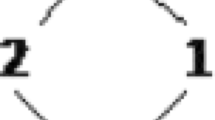Abstract
The relationships between various modal logics based on Belnap and Dunn’s paraconsistent four-valued logic FDE are investigated. It is shown that the paraconsistent modal logic \(\mathsf{BK}^\Box \), which lacks a primitive possibility operator \(\Diamond \), is definitionally equivalent with the logic \(\mathsf{BK}\), which has both \(\Box \) and \(\Diamond \) as primitive modalities. Next, a tableau calculus for the paraconsistent modal logic KN4 introduced by L. Goble is defined and used to show that KN4 is definitionally equivalent with \(\mathsf{BK}^\Box \) without the absurdity constant. Moreover, a tableau calculus is defined for the modal bilattice logic MBL introduced and investigated by A. Jung, U. Rivieccio, and R. Jansana. MBL is a generalization of BK that in its Kripke semantics makes use of a four-valued accessibility relation. It is shown that MBL can be faithfully embedded into the bimodal logic \(\mathsf{BK}^\Box \times \mathsf{BK}^\Box \) over the non-modal vocabulary of MBL. On the way from \(\mathsf{BK}^\Box \) to MBL, the Fischer Servi-style modal logic \(\mathsf{BK}^\mathsf{FS}\) is defined as the set of all modal formulas valid under a modified standard translation into first-order FDE, and \(\mathsf{BK}^\mathsf{FS}\) is shown to be characterized by the class of all models for \(\mathsf{BK}^{\Box }\times \mathsf{BK}^{\Box }\). Moreover, \(\mathsf{BK}^\mathsf{FS}\) is axiomatized and this axiom system is proved to be strongly sound and complete with respect to the class of models for \(\mathsf{BK}^{\Box }\times \mathsf{BK}^{\Box }\). Moreover, the notion of definitional equivalence is suitably weakened, so as to show that \(\mathsf{BK}^\mathsf{FS}\) and \(\mathsf{BK}^{\Box }\times \mathsf{BK}^{\Box }\) are weakly definitionally equivalent.
Similar content being viewed by others
References
Almukdad, A., and D. Nelson, Constructible falsity and inexact predicates, Journal of Symbolic Logic 49(1): 231–233, 1984.
Arieli, O., and A. Avron, Reasoning with logical bilattices, Journal of Logic, Language and Information 5(1): 25–63, 1996.
Belnap, N., How a computer should think, in G. Ryle (ed.), Contemporary Aspects of Philosophy, Oriel Press, Stockfield, 1977, pp. 30–56.
Belnap, N., A useful four-valued logic, in J. M. Dunn, and G. Epstein (eds.), Modern Uses of Multiple-Valued Logic, D. Reidel, Dordrecht, 1977, pp. 8–37.
Bou, F., F. Esteva, L. Godo, and R. Rodríguez, On the minimum many-valued modal logic over a finite residuated lattice, Journal of Logic and Computation 21(5): 739–790, 2011.
Brady, R. T., Completeness proofs for the systems \(RM3\) and \(BN4\), Logique et Analyse 25: 9–32, 1982.
Czelakowski J., and D. Pigozzi, Fregean logics, Annals of Pure and Applied Logic 127: 17–76, 2004.
Dunn, J. M., Intuitive semantics for first-degree entailments and ‘coupled trees’, Philosophical Studies 29(3): 149–168, 1976.
Fischer Servi, G., Axiomatizations for some intuitionistic modal logics, Red. Sem. Mat. Universi. Politec. Torino 42: 179–194, 1984.
Font J. M., and R. Jansana, A General Algebraic Semantics for Sentential Logics, volume 10 of Lecture Notes in Logic, Springer, Berlin, 1996.
Goble, L., Paraconsistent modal logic, Logique et Analyse 49: 3–29, 2006.
Gyuris, V., Variations of Algebraizability, PhD thesis, The University of Illinois at Chicago, 1999.
Jung, A., and U. Rivieccio, Priestly duality for bilattices, Studia Logica 100(1-2): 223–252, 2012.
Jung, A., and U. Rivieccio, Kripke semantics for modal bilattice logic, in Extended Abstracts of the 28th Annual ACM/IEEE Symposium on Logic in Computer Science, IEEE Computer Society Press, 2013, pp. 438–447.
Kracht, M., Tools and Techniques in Modal Logic, Elsevier, Amsterdam, 1999.
Meyer, R. K., S. Giambrone, and R. T. Brady, Where gamma fails, Studia Logica 43(3): 247–256, 1984.
Odintsov, S. P., The class of extensions of Nelson’s paraconsistent logic, Studia Logica 80(2-3): 291–320, 2005.
Odintsov, S. P., Constructive Negations and Paraconsistency, Springer, Dordrecht, 2008.
Odintsov, S. P., and E. I. Latkin, \(\mathbf{BK}\)-lattices. Algebraic semantics for Belnapian modal logics, Studia Logica 100(1–2): 319–338, 2012.
Odintsov, S. P., and S. O. Speranski, The lattice of Belnapian modal logics: Special extensions and counterparts, Logic and Logical Philosophy 25(1): 3–33, 2016.
Odintsov, S. P., and H. Wansing, Modal logics with Belnapian truth values, Journal of Applied Non-Classical Logics 20(3): 279–301, 2010.
Priest, G., An Introduction to Non-Classical Logic. From If to Is, Cambridge University Press, Cambridge, 2008.
Priest, G., Many-valued modal logics: a simple approach, Review of Symbolic Logic 1(2): 190–203, 2008.
Rivieccio, U., Paraconsistent modal logics, Electronic Notes in Theoretical Computer Science 278: 173–186, 2011.
Rivieccio, U., A. Jung, and R. Jansana, Four-valued modal logic: Kripke semantics and duality, J Logic Computation, published online, doi:10.1093/logcom/exv038, 2015.
Sano, K., and H. Omori, An Expansion of First-order Belnap-Dunn Logic, Logic Journal of the IGPL 22(3): 458–481, 2014.
Slaney, J., Relevant logic and paraconsistency, in L. Bertossi, A. Hunter, and T. Schaub (eds.), Inconsistency Tolerance, Lecture Notes in Computer Science 3300, Springer, Berlin, 2004, pp. 270–293.
Spinks, M., and R. Veroff, Paraconsistent constructive logic with strong negation is a contraction-free relevant logic, in J. Czelakowski (ed.), Don Pigozzi on abstract algebraic logic and universal algebra, Springer, Dordrecht (to appear).
Vakarelov, D., Notes on N-lattices and constructive logic with strong negation, Studia Logica 36(1–2): 109–125, 1977.
Author information
Authors and Affiliations
Corresponding author
Additional information
Special Issue: 40 years of FDE
Edited by Hitoshi Omori and Heinrich Wansing
Rights and permissions
About this article
Cite this article
Odintsov, S.P., Wansing, H. Disentangling FDE-Based Paraconsistent Modal Logics. Stud Logica 105, 1221–1254 (2017). https://doi.org/10.1007/s11225-017-9753-9
Published:
Issue Date:
DOI: https://doi.org/10.1007/s11225-017-9753-9



